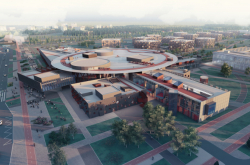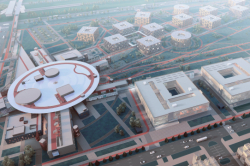Sustainable development for science and education: what are the problems that the new standard aims to solve
In September 2015, 193 countries (members of United Nations) adopted the new global development program "Transforming our world: the 2030 Agenda for Sustainable Development". It included 17 Sustainable Development Goals, which incorporated activities in the field of responsible consumption, preservation of marine and terrestrial ecosystems, promotion of the concept of sustainability in urban development, and much more.
Sustainable development is a social development model which aims to satisfy society's needs while keeping a balance between economic growth, care about the environment, and social well-being. In a natural environment, sustainability is maintained by nature's ability to renew its resources. Still, humans can maintain the principles of sustainability, as well, as long as they increase the energy-efficiency of their activities and cut on consumption of resources.
According to Vera Burtseva, CEO of the Open St. Petersburg SIE, in recent years, sustainable development as a trend has been entering all fields of human activity, urban development included. In different universities around the world, solutions are being developed that aim to ease the load on the environment and massively introduce the sustainable development concept. For instance, at Stanford University, they have fixed solar panels on the building's roof and facades, and rainwater harvesting systems are being used for saving water in the building of the Academy of Sciences in San Francisco.

In Russia, a series of national laws and regulations have been developed that aim to particularize the requirements for energy, water and economic efficiency of facilities.
GREEN ZOOM is a system of practical recommendations that aims to provide for cost reduction and successful execution of these requirements. Among the system's tasks are assessment of energy and water efficiency, as well as environmental friendliness of both existing facilities and those only being designed.
Still, until now, there has been no methodologically executed complex approach to designing innovative research and educational centers, notes Vera Burtseva. ITMO specialists used international practices, as well as international and national legislation and the GREEN ZOOM system to develop a standard that accounts for relevant general and specific requirements to such operations.
Standard's goals
GREEN ZOOM UNIVERSITIES is Russia's first system of practical recommendations for reducing power consumption and increasing water efficiency and environmental friendliness of university campuses. The standard is designed for construction of both residential and office buildings, as well as public and academic buildings, laboratories and data processing centers, as well as test production sites.
Among the document's authors were engineers, ecologists, architects, as well as experts on building regulations and standards, IT specialists and managers.

"Our task was to develop a system of world-class quality. This is why our standard is based on both the Russian legislation and practices and accounts for the UN recommendations in the field of sustainable development, comments the CEO of Open St. Petersburg SIE. Sustainable development is a trend which now attracts all the more attention on all levels. It's no wonder that ITMO University has just set about conducting a complex strategic project on launching a new research, educational and innovative center ITMO Highpark which aims to become an expert center in this field on both the national and international scale."
ITMO Highpark will be built in the Yuzhny satellite town in the Pushkinsky District of St. Petersburg. The new campus will include academic buildings, innovative production sites, and a business incubator, occupying an area of about 400 square kilometers. There will be 50 international laboratories and no less than five innovative production facilities on the campus, which will specialize in such fields as IT, photonics and quantum technologies, robotics and cyberphysical systems, biomedical technologies and smart materials.
According to Vladimir Vasilyev, ITMO University Rector, the introduction of sustainable development-based standards will offer an opportunity to not just develop the technology of designing research and educational centers in much detail, but also make it possible to replicate this experience in other projects.

"Our task comes down to building a major innovative educational center that will become the core of the scientific and inventive potential, as well as creating comfortable and effective systems for its users - talented youth, our students and professors. We actively participate in the development of the GREEN ZOOM UNIVERSITIES standard in order to make it so that the new standard would not just comply with Presidential Decrees on energy efficiency and ecological friendliness and the “Digital Economy of the Russian Federation” program, but also comply with the UN's Sustainable Development Goals that were adopted on September 25, 2015. By introducing the GREEN ZOOM UNIVERSITIES standard in ITMO Highpark innovative educational center, we will not just demonstrate them, but also set the bar for designing and developing innovative educational centers in both Russia and around the world," notes Vladimir Vasilyev.
Contents of the standard
The standard features ten sections and includes 143 recommendations on attaining environmental friendliness, energy and water efficiency, as well as decreasing costs of object maintenance.
The document's structure accounts for the fundamental goals of sustainable development according to the UN's global development program, including the provision of complex safety of transport infrastructure, reduction of carbon dioxide emission, optimization of water consumption, and integrated accounting, responsible consumption, use of renewable sources and energy efficiency concepts during construction and maintenance of buildings, and much more.
The standard is designed for all who participate in the process of launching new generation innovative centers: architects, engineers, builders, university departments and SIEs, students, manufacturers of equipment and materials.

Future prospects
"We've released the first version of the document, and we plan to develop and complement the system further on. For now, we are working on expanding the workgroup and involving other specialists and representatives of different companies in our project. We are open to both the market and the professional community. We propose companies a chance to give their expert evaluation and contribute to the development of this system that can then be used by other R&D centers," says Vera Burtseva.
The expanded workgroup will include representatives of different fields: employees of IT companies, technology developers, manufacturers of eco-friendly materials and such. What is more, the project's team has now begun to collaborate with different departments and offices of ITMO University. Here, the goal is to look for technologies and inventions that can form a pool of particular practical solutions that will be introduced at ITMO Highpark. The final version of the standard will be based on recommendations by the expert community and study of particular technologies. The team expects to present their results by December 2018.





